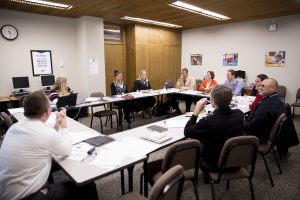Wallace Grant: A Positive Change in School Leadership
This article is the first of a series of reports on how support from the Wallace Foundation is making a difference at Des Moines Public Schools. In June 2014, DMPS was awarded a substantial grant by the Wallace Foundation to improve teaching and learning by improving the work of principals and their supervisors. DMPS is one of six urban school districts from across the country selected to participate in the initiative.

Corey Harris, the district’s middle school director, plays a key role in making sure the Wallace Grant is a success for DMPS.
The Office of Schools (OOS) was created by Des Moines Public Schools in the summer of 2013 with the primary objective of providing an enhanced level of leadership and supervision to school principals that would flow into classrooms like blood does from the heart out to the hands.
A year later DMPS was one of six districts nationwide to receive $3 million, four-year grants from the Wallace Foundation expressly aimed at enabling principal supervisors to spend more time in the field and train stronger candidates for the position of building principal. Wallace’s Principal Pipeline Initiative was launched in 2011.
What has been the impact of this hard one-two punch after years of jab, jab, jabbing away at the tough opponents faced by school principals and the managers in their corners?
In 2014-2015, the OOS was comprised of one Chief Officer, two Executive Directors (Principal Supervisor Supervisors), and five Directors (Principal Supervisors), an increase of one principal supervisor from the initial year. For the 2015-2016 school year a sixth principal supervisor was added. The ratio of supervisors to principals that was 19:1 when OOS was created is now 10:1. DMPS is now configured at what’s considered the best practice ratio for the duration of the Wallace Grant.
Already the amount of time principal supervisors spend in the field has been boosted to 60%. The objective is 70%.
In addition to providing intensified supervision for principals DMPS seeks to capitalize on the Wallace Grant by developing a districtwide pipeline of its own filled with candidates pre-groomed for success when opportunities arise to step into leadership roles. Indeed, one of the strings attached to the grant’s Principal Supervisor Initiative is that the district must develop stronger candidates for the position.
On January 11th eight hand-picked trainees began an intensive 12-week training course led by Chief of Schools Matt Smith, Executive Director of Secondary Schools Tim Schott and Executive Director of Elementary Schools Susie Tallman. It is one prime example of the district’s new “Grow Our Own” philosophy in action.
Directors and Executive Directors from the OOS recommended candidates and the following eight accepted invitations to the new Aspiring Principals Program (APP):
- Karen Catron – Cattell Elementary – Released Dean
- Bradley Paul – King Elementary – Released Dean
- Emily Behrens – South Union Elementary – Released Dean
- Joshua Griffith – Callanan Middle School – Vice Principal
- Joseph Green – Hoyt Middle School – School Improvement Leader
- Elizabeth Ahrens – East High School – Vice Principal
- Edward JR Mcculley – North High School – Vice Principal
- Kisha Barnes – Curriculum – World Language & IB Curriculum Coordinator
Besides the common training the group will receive it is hoped that they will form a professional learning community or PLC that will endure beyond their shared training period and become an ongoing network for mutual support and collaboration.
They meet every Monday after school for several hours in the district’s central offices.
Corey Harris’s hiring for the 2013-14 school year as the district’s Director of Middle Schools coincided with the establishment of the Office of Schools. He took a newly created position that was already aligned with the best practices principal supervisory ratio by virtue of the fact that DMPS has 10 middle schools. So there was a baseline in place even before the Wallace Grant was awarded.
Now, two and a half years out, there are trend lines developing in terms of student achievement and behavior at the middle school level, a key developmental crossroads.
Proficiency in reading is up more than 20% as measured by the Iowa Assessment which is administered every spring. Proficiency in math hasn’t increased as dramatically but has risen each year. Science scores are up by double digits. After spiking in 2013-14, office referrals dropped by 16% the following year. Out of school suspensions plummeted by 29% over the same period. Attendance goals in excess of 95% for both middle school students and staff have been surpassed.
Harris says the real significance of the Wallace Grant goes beyond its financial resources.
“The dollars are important but overall they are a tiny fraction of the district’s budget,” he said. “Wallace’s biggest impact is that it’s shaping our decision-making.”
He’s boyish-looking but seasoned. Harris has been a building principal in five different states across all elementary and secondary levels. Nothing he has experienced elsewhere has excited him as much as what’s unfolding here. He talks enthusiastically about more focused collaboration and increased accountability that are based on shared understanding of common objectives, districtwide.
Audrey Rieken is in her fifth year as the principal at Weeks Middle School. Prior to that, she served as a vice-principal there for two years.
“Yes, there is a difference in our work with Corey since the Wallace Grant,” she says. “Our collaborative meetings have been more focused on instruction. Corey’s weekly memos are also focused on our SIP (School Improvement Plan) goals this year. We have used this information in our building PDs (professional development) to focus on instruction. He has provided meaningful PD for our whole leadership team.”
Ah yes, those weekly memos. Harris regularly shares updates and data, not just with his principals but with every employee in those buildings. Relationships that previously felt built on one position’s oversight of another now feel more mutually helpful and reinforcing.
Rieken’s perspective is before/after at Weeks. Harding principal Joy Linquist’s is here/there since she came to DMPS from a neighboring suburban district. Her basis for comparison is also telling.
“I have had an immense amount of support provided to me,” she said. “It’s been vastly different from other districts.”
Examples include frequent building walk-throughs and professional development under the direction of Harris.
The overarching philosophy guiding the sweeping administrative rethink is the Marzano Instructional Framework. What’s that? In a nutshell: “A defining characteristic of the model is its unique… approach that allows for specific feedback to teachers and specific guidance to teachers that can be provided by administrators and instructional coaches.”
That’s website-speak for an evaluation model that trains and measures everyone against meaningful, demonstrable standards instead of according to personal impressions, hunches and bias.
Harris “provides significant feedback for improvement around Marzano’s leadership framework,” said Linquist, who is in her first year at Harding. “In my last experience I did not see central office support in our building more than a few times per year…District leadership was invited multiple times to join us for professional development and classroom walk-throughs. They often were not available due to other priorities. The DMPS system is designed to provide direct support to building leaders that is timely.”
Nowhere is it more important for everyone involved to be on the same page than in a large, diverse, urban school district. The Wallace Grant is supplying both resources and guidance that are turning attentions district-wide, across all levels, to that critical common focus.






